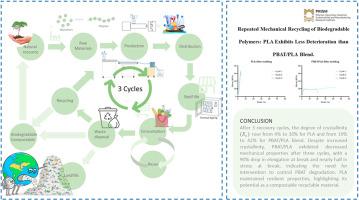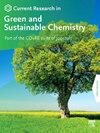生物可降解聚合物的重复机械回收:聚乳酸的劣化程度低于 PBAT/PLA 混合物
Q2 Materials Science
Current Research in Green and Sustainable Chemistry
Pub Date : 2024-01-01
DOI:10.1016/j.crgsc.2024.100430
引用次数: 0
摘要
作为不可生物降解化石基聚合物的替代品,生物可降解聚合物已得到广泛研究。虽然生物降解聚合物可减少对环境的影响,但其生产需要占用粮食作物所需的土地。因此,探索生物降解聚合物的再利用和再循环对提高其循环经济性和可持续性至关重要。本研究评估了市售生物可降解聚合物聚乳酸(PLA)及其与聚(己二酸丁二醇酯共对苯二甲酸酯)混合物(PBAT)在三个机械回收周期中的可回收性。每个循环模拟塑料生产、保质期、清洗和再加工阶段。使用差示扫描量热仪 (DSC)、傅立叶变换红外光谱仪 (FTIR)、拉伸测试和流变分析对每个循环中成型、老化和清洗后的样品进行分析,以跟踪结晶、化学结构、粘度和机械行为的变化。结果表明,由于老化和水洗的退火效应,聚乳酸和 PBAT/PLA(55/45 wt%)混合物的结晶度(Xc)都有所提高。经过一个循环后,傅立叶变换红外光谱和 Xc 均未发生变化,这表明产品具有稳定性。经过三个再加工循环后,聚乳酸的二次加热结晶度从 2% 上升到 13%,PBAT/PLA(45 wt% 聚乳酸)的二次加热结晶度从 2% 上升到 12%,这表明降解和分子量降低引起了形态变化。尽管与聚乳酸相比,PBAT/PLA 的结晶度更高,复合粘度和储存模量的下降幅度更小,但其机械性能却有所下降,断裂伸长率下降了 90%,断裂应力下降了近 50%,这突出表明需要采取干预措施来控制 PBAT 降解。聚乳酸保持了较强的机械性能,显示了其作为可堆肥回收材料的潜力。本文章由计算机程序翻译,如有差异,请以英文原文为准。

Repeated mechanical recycling of biodegradable polymers: PLA exhibits less deterioration than PBAT/PLA blend
Biodegradable polymers have been extensively researched as alternatives to non-biodegradable fossil-based polymers. Although they reduce environmental impact, their production competes with land needed for food crops. Therefore, exploring their reuse and recycling is essential for enhancing their circular economy and sustainability. This study evaluated the recyclability of commercially available biodegradable polymers, poly (lactic acid) (PLA) and its blend with poly (butylene adipate co-terephthalate) (PBAT), across three cycles of mechanical recycling. Each cycle simulates plastic production, shelf-life, washing, and reprocessing stages. Samples were analysed after molding, ageing, and washing for each cycle using Differential Scanning Calorimetry (DSC), Fourier-transform infrared spectroscopy (FTIR), tensile testing, and rheological analysis to track changes in crystallization, chemical structure, viscosity, and mechanical behaviors. Results indicated that both PLA and PBAT/PLA (55/45 wt%) blend showed a rise in crystallinity () due to the annealing effect of the ageing and washing. No changes in FTIR spectra and were detected after one recycling cycle, indicating stability. After three reprocessing cycles, second heating crystallinity rose from 2 % to 13 % for PLA and from 2 % to 12 % for PBAT/PLA (45 wt% PLA), indicating morphological changes from degradation and molecular weight reduction. Despite higher crystallinity and a more moderate decline in complex viscosity and storage modulus than PLA, PBAT/PLA showed reduced mechanical properties, with a 90 % drop in elongation at break and nearly 50 % in stress at break, highlighting the need for interventions to control PBAT degradation. PLA maintained strong mechanical properties, demonstrating its potential as a compostable recyclable material.
求助全文
通过发布文献求助,成功后即可免费获取论文全文。
去求助
来源期刊

Current Research in Green and Sustainable Chemistry
Materials Science-Materials Chemistry
CiteScore
11.20
自引率
0.00%
发文量
116
审稿时长
78 days
 求助内容:
求助内容: 应助结果提醒方式:
应助结果提醒方式:


